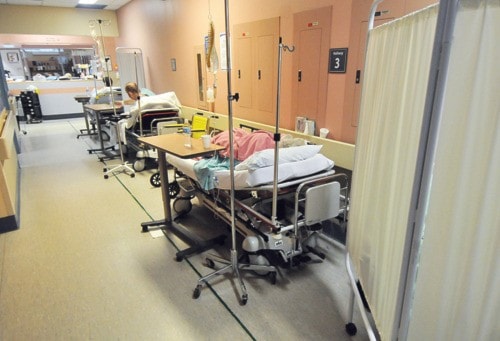Officials at Abbotsford Regional Hospital (ARH) are trying to get people out of the corridors and acute care beds and reduce overall congestion as part of a broad initiative across Fraser Health.
One of the new methods includes having home care staff based at emergency departments to intercept incoming elderly patients. Some can be redirected back home and treated there with sufficient home support, according to Brook Richardson, executive director of ARH.
“At this time we’re moving forward to streamline operations. And it’s more than just a hospital perspective, it’s also a community perspective,” she said, adding it’s about using multiple resources of formal and informal care.
The hospital’s emergency department has a geriatric nurse who focuses on elderly patients and liaises with external healthcare workers to keep hospital beds free for acute care.
The move coincides with a deadline set for Fraser Health by Health Minister Mike de Jong to pursue measurable improvements in five key areas to reduce hospital congestion within 150 days.
One of the numbers de Jong wants to see drop is the roughly 100 patients across Fraser Health who at any given time are being treated in hallways or other areas not designed for clinical care.
Fraser Health spokesman Roy Thorpe-Dorward said that number is typically about 10 patients in ARH on heavily congested days.
But Linda Pipe, spokeswoman for the Fraser Valley region of the B.C. Nurses’ Union, says that number is closer to 20 or 30, because of those patients who are temporarily placed in bathrooms or closets.
She said ARH has been struggling to meet demand since it opened four years ago with roughly the same number of beds as the old hospital.
“They (the provincial government) closed St. Mary’s and they closed Shaughnessy, and you’re seeing the repercussions of what they’ve done there,” she said.
Nurses are struggling physically and ethically with having to work with patients in hallways, citing a lack of privacy, confidentiality and toilet facilities. The latter is particularly important because without proper hand-washing facilities there will be a rise in infection rates, she said.
But Thorpe-Dorward said infections like C difficile aren’t as much of an issue in Abbotsford because it’s a newer facility. He said Abbotsford’s year-to-date rates are 4.6 cases per 10,000 patients, down one per cent from last year, and well below the national average.
ARH’s enhanced cleaning and hand-washing strategies also take credit, he said.
Other minister-set targets include a cut in the average length of patient stay in hospital, an increase in the percentage of admitted ER patients getting a hospital bed within 10 hours; and a goal of treating 90 per cent of broken hip cases within 48 hours.
Pipe said these goals seem unrealistic with a deficit of community health workers and registered nurses.
“We agree that the best place for people to live out their remaining lives, especially seniors, is in their home. The problem is there’s not enough staff to look after them.”
Fraser Health last year treated 3.9 per cent more hospital patients and recorded a five per cent increase in inpatient days as well as a 7.3 per cent jump in ER visits.
The 2,200 acute care beds across 12 hospitals are routinely full.
Richardson said more specialized hospitals like ARH routinely absorbs patients from outside their municipality.
“When I think of Hope and Chilliwack and those smaller communities, Abbotsford is a higher level of care facility, so we welcome individuals coming from other parts of the Fraser Health area,” she said.
An independent expert panel interviewed 500 clinicians and workers in Surrey Memorial and Royal Columbian hospitals, releasing a report in April identifying congestion issues across Fraser Health.
— with files from Jeff Nagel
